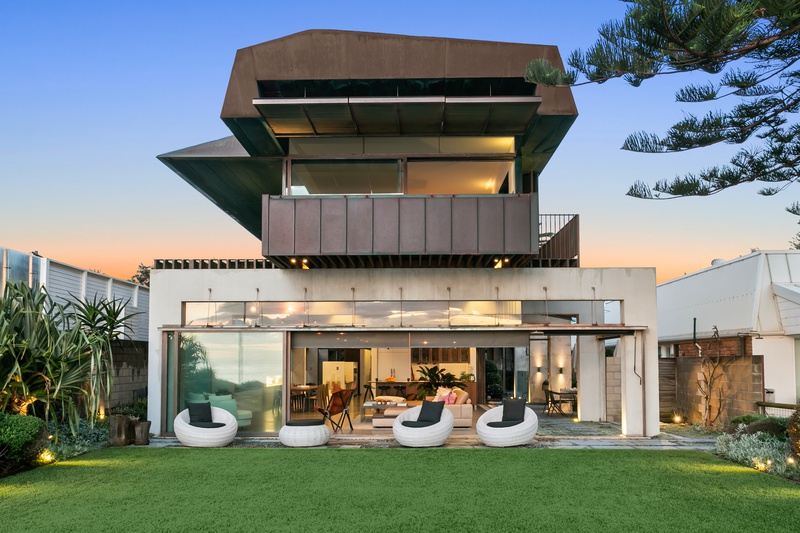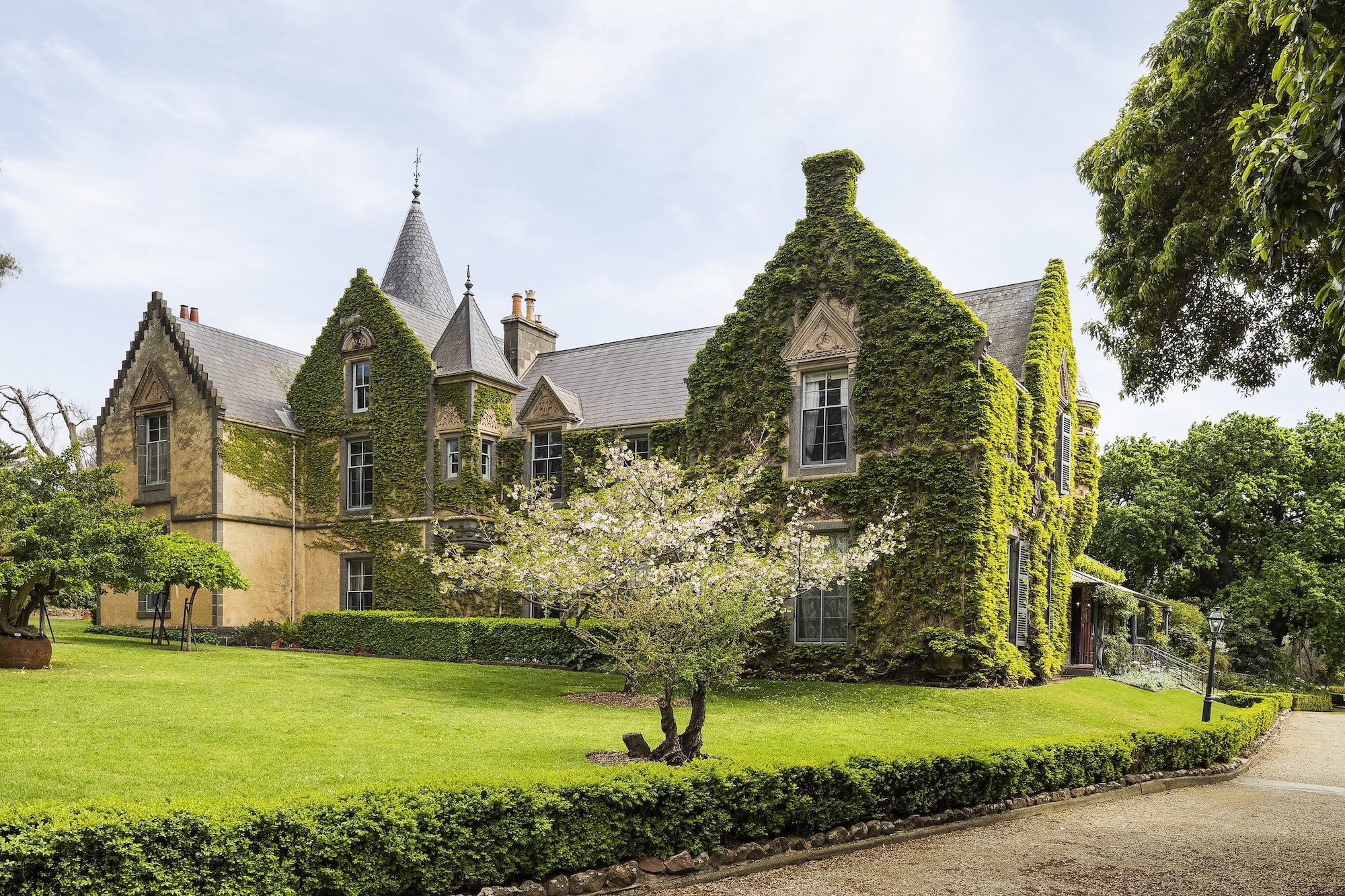Dual-Frontage Belongil Beach Hideaway Listed for $35m
With two waterfronts, bushland surrounds and a $35 million price tag, this Belongil Beach retreat could become Byron’s most expensive home ever.
A rare parcel of Byron Bay is primed to hit the market this week along the glamorous holiday spot’s priciest stretch of sand – Belongil Beach.
The designer digs belong to Leah and Kurt Rettenmaier, head of digital asset investment firm Revolution Tech. The couple have listed their Byron Bay hideaway, which sits on Childe St and has two waterfronts, for $35 million with Kim Jones of Jones & Co Real Estate.
The Rettenmaiers bought an original beach house on the 1776sq m block back in 2016 for $3.6 million, according to title records, and then reimagined the unique property into a sleek boho retreat worthy of its multimillion-dollar price tag.
The three-bedroom, two-bathroom compound at 4 Childe St sits at the end of the enviable strip, which is bordered on three sides by Belongil Beach, the Belongil Creek and uninterrupted bushland teeming with native flora and fauna.
In addition to the natural neighbours, the property is also surrounded by VIP residents in the exclusive peninsula, including Chemist Warehouse boss Damien Gance and Sasha Robertson.
If the Rettenmaiers and Jones achieve their $35 million goal, the newest listing could break the Byron price barrier of $33.5 million set by the Gance-Robertsons earlier this year.
Jones is also reportedly the agent behind the current Far North Coast record of $37 million. That deal was struck when Tom and Emma Lane of Oroton handbag fame bought their property, The Range, in nearby Coopers Shoot.
The primary two-bedroom residence is home to rendered white walls with integrated shelving and statement archways reminiscent of the uniquely smooth lines of the Greek Isles. The flowing curved interiors also reflect the calming contours of the coastal landscape on the home’s doorstep.
Designed for entertaining inside and out, the property features a spacious covered alfresco area with a built-in barbecue, manicured lawns, a bespoke fire pit and a private self-contained studio with an outdoor claw-foot bathtub.
Even kids – big or small – have room to play with a fun built-in skate ramp and an expansive beachfront lawn with sweeping views over the bay, Julian Rocks and the iconic Cape Byron Lighthouse.
The dream has space to thrive with architect-designed plans for a more contemporary beach house (STCA).
Perfectly positioned for surfing at coveted Belongil Beach, or kayaking and stand up paddle boarding along the creek, the home’s prized location is within 600m of Treehouse restaurant, is a six-minute walk to the heart of Byron Bay and approximately half an hour to the Ballina/Byron Gateway Airport, or less than an hour to the Gold Coast Airport.
The dual aspect home at 4 Childe St, Byron Bay, is listed with Kim Jones of Jones & Co with price expectations of about $35 million.
Records keep falling in 2025 as harbourfront, beachfront and blue-chip estates crowd the top of the market.
A divide has opened in the tech job market between those with artificial-intelligence skills and everyone else.
The 2026 McGrath Report warns that without urgent reforms to planning, infrastructure and construction, housing affordability will continue to slip beyond reach for most Australians.
Australia’s housing market has reached a critical juncture, with home ownership and rental affordability deteriorating to their worst levels in decades, according to the McGrath Report 2026.
The annual analysis from real estate entrepreneur John McGrath paints a sobering picture of a nation where even the “lucky country” has run out of luck — or at least, out of homes.
New borrowers are now spending half their household income servicing loans, while renters are devoting one-third of their earnings to rent.
The time needed to save a 20 per cent deposit has stretched beyond ten years, and the home price-to-income ratio has climbed to eight times. “These aren’t just statistics,” McGrath writes. “They represent real people and real pain.”
McGrath argues that the root cause of Australia’s housing crisis is not a shortage of land, but a shortage of accessibility and deliverable stock.
“Over half our population has squeezed into just three cities, creating price pressure and rising density in Sydney, Melbourne and Brisbane while vast developable land sits disconnected from essential infrastructure,” he says.
The report identifies three faltering pillars — supply, affordability and construction viability — as the drivers of instability in the current market.
Developers across the country, McGrath notes, are “unable to make the numbers work” due to labour shortages and soaring construction costs.
In many trades, shortages have doubled or tripled, and build costs have surged by more than 30 per cent, stalling thousands of projects.
Need for systemic reform
McGrath’s prescription is clear: the only real solution lies in increasing supply through systemic reform. “We need to streamline development processes, reduce approval timeframes and provide better infrastructure to free up the options and provide more choice for everyone on where they live,” he says.
The 2026 edition of the report also points to promising trends in policy and innovation. Across several states, governments are prioritising higher-density development near transport hubs and repurposing government-owned land with existing infrastructure.
Build-to-rent models are expanding, and planning reforms are gaining traction. McGrath notes that while these steps are encouraging, they must be accelerated and supported by new construction methods if Australia is to meet demand.
One of the report’s key opportunities lies in prefabrication and modular design. “Prefabricated homes can be completed in 10–12 weeks compared to 18 months for a traditional house, saving time and money for everyone involved,” McGrath says.
The report suggests that modular and 3D-printed housing could play a significant role in addressing shortages while setting a new global benchmark for speed, cost and quality in residential construction.
Intelligent homes
In a section titled Weathering the Future: The Power of Smart Design, the report emphasises that sustainable and intelligent home design is no longer aspirational but essential.
It highlights new technologies that reduce energy use, improve thermal efficiency, and make homes more resilient to climate risks.
“There’s no reason why Australia shouldn’t be a world leader in innovative design and construction — and many reasons why we should be,” McGrath writes.
Despite the challenges, the tone of the 2026 McGrath Report is one of cautious optimism. Demand is expected to stabilise at around 175,000 households per year from 2026, and construction cost growth is finally slowing. Governments are also showing a greater willingness to reform outdated planning frameworks.
McGrath concludes that the path forward requires bold decisions and collaboration between all levels of government and industry.
“Australia has the land, demand and capability,” he says. “What we need now is the will to implement supply-focused solutions that address root causes rather than symptoms.”
“Only then,” he adds, “can we turn the dream of home ownership back into something more than a dream.”
A divide has opened in the tech job market between those with artificial-intelligence skills and everyone else.
From Italy’s $93,000-a-night villas to a $20,000 Bowral château, a new global ranking showcases the priciest Airbnbs available in 2026.



























